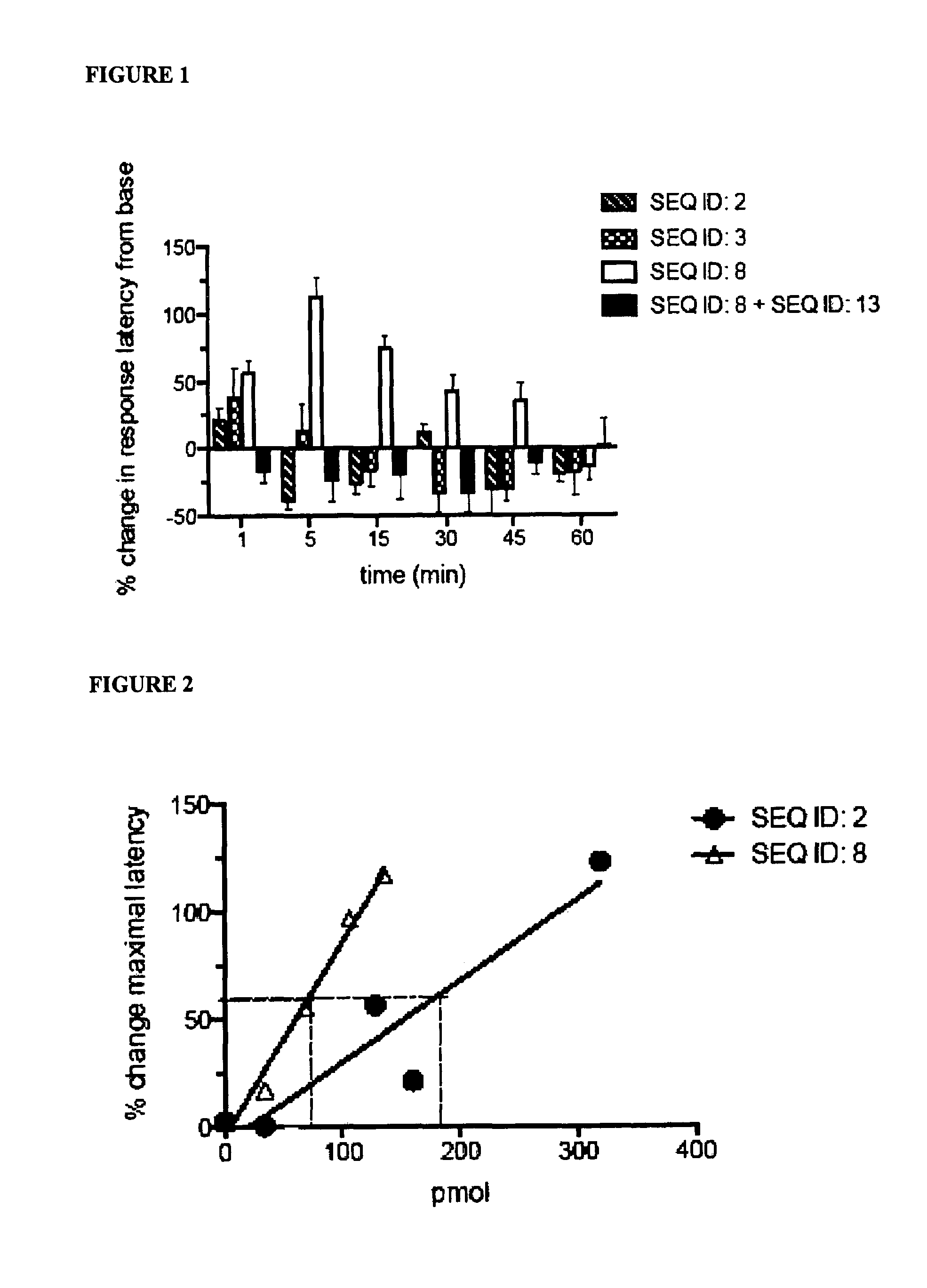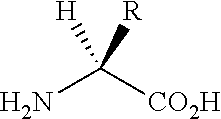Nociceptin mimetics
a technology of mimetics and nociceptin, which is applied in the field of nociceptin peptide mimetics, can solve the problems of not having a three-dimensional structure of orl-1 g protein-coupled receptors, either in complexes with ligands or alone, and achieves enhanced potency, modulating orl-1 receptor function, and improved serum stability
- Summary
- Abstract
- Description
- Claims
- Application Information
AI Technical Summary
Benefits of technology
Problems solved by technology
Method used
Image
Examples
example 1
Peptide Synthesis
[0096]Nociceptin analogues were prepared on 0.15 mmol scale by manual stepwise solid phase peptide synthesis using HBTU / DIPEA activation for Fmoc chemistry [Kates and Albericio, 2000, Solid-Phase Synthesis: A Practical Guide, Eds: Kates and Albericio, Marcel Dekker, NY] on Rink Amide MBHA LL resin (substitution 0.37 mmol·g−1). Fmoc deprotections were achieved with 2×5 min treatments with DMF / Piperidine (1:1). Four equivalents of amino acid and four equivalents of diisopropylethylamine (DIPEA) were employed in each coupling step (15 min), except for Fmoc-Asp(OPip)-OH and Fmoc-Lys(Mtt)-OH where only 2 equivalents were coupled using HATU and DIPEA activation. Coupling yields were monitored by quantitative ninhydrin assay [Kaiser et al., 1970, Anal. Biochem. 34:595-598] and double couplings were employed for yields below 99.6%. After the first Fmoc-Lys(Mtt)-OH residue was coupled, the phenylisopropyl ester of aspartic acid and methyltrityl group of lysine were removed b...
example 2
NMR Spectroscopy
[0099]The sample for NMR analysis of SEQ ID NOs:6 and 7 were prepared by dissolving the peptide (2.0-5.0 mg) in 540 μL H2O and 60 μL D2O. 1D and 2D 1H-NMR spectra were recorded on a Bruker Avarice DRX-600 spectrometer. 2D 1H-spectra were recorded in phase-sensitive mode using time-proportional phase incrementation for quadrature detection in the t1 dimension. [Marion, Wüthrich, 1983, Biochem. Biophys. Res. Commun., 113:967-974] The 2D experiments included TOCSY (standard Bruker mlevgpph pulse program) and NOESY (standard Bruker noesygpph pulse program) and dqfCOSY (standard Bruker dqfcosygpph pulse program). TOCSY spectra were acquired over 6887 Hz with 4096 complex data points in F2, 256 increments in F1 and 16 scans per increment. NOESY spectra were acquired over 6887 Hz with 4096 complex data points in F2, 512 increments in F1 and 32 scans per increment. TOCSY and NOESY spectra were acquired with several isotropic mixing times of 80 ms for TOCSY and 350 ms for NOE...
example 3
Circular Dichroism Spectrocopy
[0106]CD measurements were performed using a Jasco model J-710 spectropolarimeter which was routinely calibrated with (1S)-(+)-10-camphorsulfonic acid. A stock solution of 1-2 mg of peptide was dissolved in 1 mL of water. Separate 500 μL solutions of 50, 100, 200 and 400 μM were then prepared using an appropriate amount of stock solution and making up the different with 10 mM Phosphate Buffer (final pH 7.1). Spectra were recorded at room temperature (298 K), with a 0.1 cm. Jasco quartz cell over the wavelength range 260-185 nm at 100 nm / min. with a bandwidth of 1.0 nm, response time of 2 s, resolution step width of 1 nm and sensitivity of 20-50 Mdeg. Each spectrum represents the average of 5 scans. Spectra were analyzed using the spectral analysis software and smoothed using ‘adaptive smoothing’ function. Concentrations were determined using the PULCON method. [Wider, Dreier, 2006, J. Am. Chem. Soc. 128:2571-2576]
[0107]The results are shown in Table 8.
[...
PUM
| Property | Measurement | Unit |
|---|---|---|
| pH | aaaaa | aaaaa |
| volume | aaaaa | aaaaa |
| dihedral angle | aaaaa | aaaaa |
Abstract
Description
Claims
Application Information
 Login to View More
Login to View More - R&D
- Intellectual Property
- Life Sciences
- Materials
- Tech Scout
- Unparalleled Data Quality
- Higher Quality Content
- 60% Fewer Hallucinations
Browse by: Latest US Patents, China's latest patents, Technical Efficacy Thesaurus, Application Domain, Technology Topic, Popular Technical Reports.
© 2025 PatSnap. All rights reserved.Legal|Privacy policy|Modern Slavery Act Transparency Statement|Sitemap|About US| Contact US: help@patsnap.com



